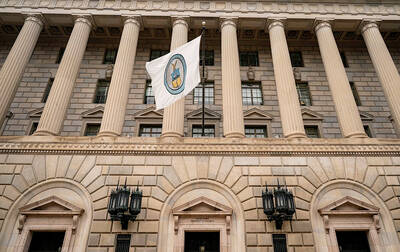Gold could hit levels last seen in 2013 if the US dollar extends its slide and equity markets reverse.
Bullion at US$1,400 an ounce is “achievable” in the next two months, Stephen Innes, head of trading for Asia Pacific at brokerage Oanda Corp, said in an interview Thursday.
The Bloomberg Dollar Spot Index plunged to the lowest since 2014 after US Secretary of the Treasury Steven Mnuchin endorsed the currency’s drop at the orld Economic Forum in Davos, Switzerland.
And while global equity markets have repeatedly hit all-time highs over the past few months, gold is also on the march, rising to as much as US$1,366.15 an ounce on Thursday, its best mark since August 2016.
The metal for immediate delivery on Friday climbed 0.2 percent to US$1,361.12 an ounce, up 2.2 percent for the week, while an index of the dollar dropped by 0.5 percent.
Gold has climbed more than 8 percent since the middle of last month as the US dollar slumped and investors sought protection from a potential tumble in share markets and a resurgence of inflation.
Holdings of bullion in exchange-traded funds have grown to the largest since 2013, while money managers have more than doubled their net bullish bets on Comex since the middle of last month.
“We see a host of ongoing financial market drivers keeping the gold market tight,” Australia & New Zealand Banking Group Ltd (ANZ) analysts, including Daniel Hynes, said in a report Thursday. “Further weakness in the dollar and rising risks of a correction in equity markets, in particular, should be supportive.”
The US dollar’s decline has come amid expectations that other central banks, notably the European Central Bank and the Bank of Japan, are moving closer to cutting monetary stimulus.
In Davos, Mnuchin said that “a weaker dollar is good” for US trade, while US Secretary of Commerce Wilbur Ross said the US would fight harder to protect its exporters.
With the US dollar “prone and defenseless,” these comments added “fuel to the fire,” Singapore-based Innes said.
With these signals from the US government and other central banks, “we’re getting into a structurally weak dollar, and on a macro level, we could be moving into a cyclical bear market beyond 2018,” Innes said. “All I can possibly see right now, given this overriding weaker dollar narrative, is for gold to go higher in the short term.”
ANZ sees prices holding at current levels in the first half of this year, before pushing toward US$1,400 by the end of the year.
A cap on the US dollar this year would be useful to US trade and managing the country’s escalating debt burden, said Gavin Wendt, senior resource analyst at MineLife Pty, who also sees gold hitting US$1,400 this year.
Other metals:
Spot silver climbed and platinum rose for a third day, while palladium fell.
Vanadium has soared more than 130 percent in the past year, outperforming better-known battery components like cobalt, lithium and nickel.
Vanadium pentoxide, a powder form of the metal used in batteries and the steel industry, has rallied 27 percent this year to US$12.38 a pound, Metal Bulletin PLC said.

Taiwan’s rapidly aging population is fueling a sharp increase in homes occupied solely by elderly people, a trend that is reshaping the nation’s housing market and social fabric, real-estate brokers said yesterday. About 850,000 residences were occupied by elderly people in the first quarter, including 655,000 that housed only one resident, the Ministry of the Interior said. The figures have nearly doubled from a decade earlier, Great Home Realty Co (大家房屋) said, as people aged 65 and older now make up 20.8 percent of the population. “The so-called silver tsunami represents more than just a demographic shift — it could fundamentally redefine the

The US government on Wednesday sanctioned more than two dozen companies in China, Turkey and the United Arab Emirates, including offshoots of a US chip firm, accusing the businesses of providing illicit support to Iran’s military or proxies. The US Department of Commerce included two subsidiaries of US-based chip distributor Arrow Electronics Inc (艾睿電子) on its so-called entity list published on the federal register for facilitating purchases by Iran’s proxies of US tech. Arrow spokesman John Hourigan said that the subsidiaries have been operating in full compliance with US export control regulations and his company is discussing with the US Bureau of

Businesses across the global semiconductor supply chain are bracing themselves for disruptions from an escalating trade war, after China imposed curbs on rare earth mineral exports and the US responded with additional tariffs and restrictions on software sales to the Asian nation. China’s restrictions, the most targeted move yet to limit supplies of rare earth materials, represent the first major attempt by Beijing to exercise long-arm jurisdiction over foreign companies to target the semiconductor industry, threatening to stall the chips powering the artificial intelligence (AI) boom. They prompted US President Donald Trump on Friday to announce that he would impose an additional

Pegatron Corp (和碩), a key assembler of Apple Inc’s iPhones, on Thursday reported a 12.3 percent year-on-year decline in revenue for last quarter to NT$257.86 billion (US$8.44 billion), but it expects revenue to improve in the second half on traditional holiday demand. The fourth quarter is usually the peak season for its communications products, a company official said on condition of anonymity. As Apple released its new iPhone 17 series early last month, sales in the communications segment rose sequentially last month, the official said. Shipments to Apple have been stable and in line with earlier expectations, they said. Pegatron shipped 2.4 million notebook